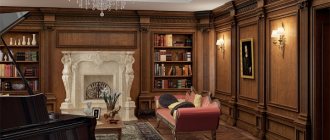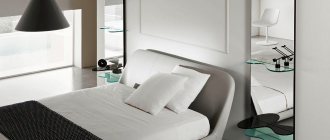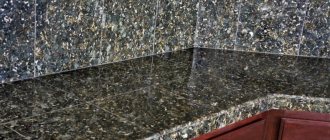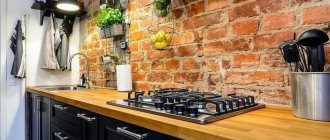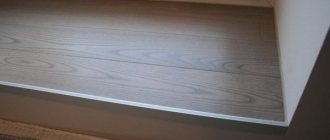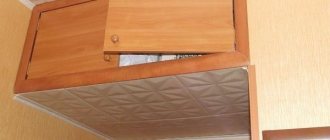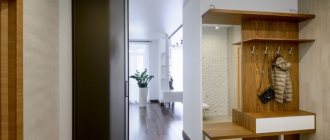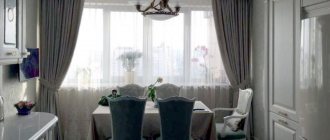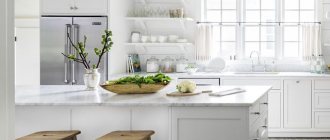Modern interior designs are quite bright and unpredictable in principle. Often, they become such using laminate on the wall in the kitchen. The solution is relatively new, but has already become quite popular and in demand.
Laminate is a durable and incredibly impressive material that is perfect not only as a floor covering, but also as a wall and even ceiling design. It comes in various shades, textures, imitation of natural wood or stone. The material is easy to maintain, durable and has a modern aesthetic appearance.
What is special about laminate walls?
The use of laminate as a finishing material for walls in the kitchen is dictated by its main advantages. These include:
- ease of installation. Even novice craftsmen can perform the entire complex of work;
- availability. In terms of cost, laminated boards are significantly inferior to solid wood panels and parquet boards;
- wear resistance. A material of a suitable class resists external influences well. The formed coating retains its presentable appearance for a long time;
- soundproofing properties. Walls lined with laminate better protect the interior from external noise;
- the ability to select panels with improved characteristics that are not afraid of exposure to high temperatures, high humidity and shocks;
- a large assortment. You can choose boards of a suitable color and with the desired texture;
- possibility of zoning space. Laminated panels help place accents and attract attention;
- ease of care.
Although laminated boards have many advantages, when choosing this method of finishing walls in the kitchen, you need to remember that:
- prolonged contact with water and prolonged exposure to high humidity reduce the service life of the panels and deteriorate their appearance;
- Careful leveling of the base may be required;
- the possibility of using the material to decorate a small area of wall.
The joy of experimentation
Laminate has firmly taken its place - it has become a budget-friendly and high-quality substitute for natural coatings. It imitates any type of wood, from affordable pine to exotic African oak.
New collections are launched into production immediately after the annual exhibitions of interior salons. The relatively inexpensive material reflects the latest trends in the design world!
Experimenting with non-traditional kitchen finishing with laminate has become a kind of fashion, a life hack. Try it too!
What characteristics should you pay attention to when choosing?
When starting to choose a suitable model, you should decide on the purpose of the purchase. If you need to disguise crumbling plaster, you should choose rigid panels of any type. If you want to update your interior, you should consider that:
- boards with a lock that allows changes in the position of the coating relative to the base will cause problems during the installation process;
- panels of different colors with visually identical locks may not connect to each other during the installation process. This will cause unwanted gaps to appear. To avoid this, lock compatibility should be checked upon purchase;
- a laminate with the highest possible moisture resistance class is preferable, since in the kitchen the humidity level is always higher;
- the thicker the panels, the smaller the internal space will become, and the outer edge will be more difficult to decorate;
Attention! Laminate should not be used to decorate the apron. Ceramic tiles or glass are best suited for this area.
Types of materials and what is needed for installation
Laminate flooring offered for sale may differ significantly from each other. First of all, you should pay attention to the strength class of the material. To finish a wall, you do not need a coating of class 32-33, since there will be practically no load on it, which means you can buy a material with average strength characteristics, thereby saving your own budget.
Also, when choosing a material, you should pay attention to the type of board. It can be with or without a locking connection. It is better to choose the castle type, it is the most popular now and is offered in an assortment of colors and textures. When laying, using a lock simplifies joining of boards. The result is a strong connection that does not require the use of glue.
If you choose a material without a locking connection, you will need to act as carefully as possible during installation. It is necessary to apply glue to the joints, securely fixing the boards to avoid gaps in the future.
Also, for installation work you will need a set of additional materials and tools:
- Level for leveling boards;
- Drill with bits for drilling socket boxes;
- Fastening material;
- Liquid nails or specialized glue for laminate flooring;
- Corner and pencil for marking.
This set of tools and additional accessories will be required for the procedure of gluing the laminate onto a solid base. When calculating the purchased laminate, make a small reserve, at least 10% of the total volume. During installation, you will have to cut the boards, which can lead to defects, especially if you do not have the necessary experience.
Comparison with wallpaper
Manufacturers offer a large number of wallpapers that differ from each other not only in appearance, but also in technical characteristics. Roll materials have a presentable appearance. Presented in a large assortment. Manufacturers offer canvases that imitate various natural materials, including wood. However, in terms of their characteristics, they are significantly inferior to laminate. They cannot be used to create an apron, since the material is not able to resist fire and moisture. Washable models allow for periodic cleaning. However, only some of them allow the use of detergents.
Laminated boards can be washed multiple times. Contaminants that appear on their surface are more easily removed. Manufacturers offer a large number of detergents designed specifically for cleaning laminated surfaces. Using them makes it easier to remove settled dirt. As a result, the formed surface retains its original appearance longer.
TOP 5 manufacturers
- Egger
Manufacturer from Austria with more than 50 years of experience in the production of floor coverings. Offers a variety of collections and products at reasonable prices. Uses environmentally friendly, safe materials in production.
- Floorwood
A Chinese company engaged in the production of high-quality laminated coatings. Specializes in the production of materials for the home. The main advantage is the affordable price of the product in comparison with analogues.
- Quick-Step
One of the leading companies on the Russian market. It uses European equipment and high-quality raw materials, so that the products meet high quality standards. It offers its own original solutions, both in product design and functionality, develops new fastenings for segments, and improves the strength characteristics of the material.
- Tarkett
One of the best manufacturers with their own production facilities in the Russian Federation. The products combine original design, quality, and affordable price. The catalog contains models with a chamfer, without a chamfer, with various types of fastenings, for any interior.
5.Pergo
A Swedish company that is the developer of modern laminated coatings in the form in which we are accustomed to seeing them. It offers products of the mid-price group and above, but at the same time, it can surprise you with the richness of its collections and quality, which has no analogues among its competitors.
Comparison with tiles
Ceramic tiles are a sought-after and popular material when decorating kitchen walls. Most often, it is used to design a work area. The material is not afraid of exposure to fire and moisture, which makes it a popular option when decorating an apron. However, the use of tiles when decorating a dining area is limited.
Laminate allows you to beautifully decorate the area adjacent to the dining group. The surface looks beautiful. In addition, you can also use it to decorate your apron beautifully. To do this, instead of conventional panels, you need to choose a moisture-resistant version, which will retain its geometry and properties even during prolonged use in conditions of high humidity. Due to this, you can beautifully decorate all the walls in the kitchen. In addition, the cost of laminated boards is often lower than ceramic tiles.
Kinds
There are two main types of laminated boards used to decorate walls. They differ in installation method and design. When choosing a suitable variety, it is worth comparing its advantages and disadvantages. This will allow you to make a choice in favor of a suitable variety.
Sheet piling
Such panels have complex geometry. Special locks are used to connect individual panels. As a result, a continuous coating is formed, in which one board is securely connected to another. When installed correctly, the result is a perfectly flat surface, even if the base has not been properly prepared.
pros
- availability;
- large assortment of colors, sizes, textures;
- ease of installation;
- high wear resistance;
- thermal insulation and noise insulation properties;
- presentable appearance;
- ease of care;
- durability;
- environmental friendliness.
Minuses
- sensitivity to the effects of abrasive of certain models;
- insufficient level of protection from moisture;
- demands on the quality of the installation performed;
- low repairability of the damaged top layer;
- change in geometric parameters with temperature fluctuations.
Adhesive
This category includes elastic two-layer vinyl panels. The top layer provides protection from external influences. The bottom one is the main one. The absence of a locking connection simplifies installation work. With its help you can beautifully decorate an uneven surface. In this case, a fairly durable and flexible coating is formed. To fix the panels to the wall, liquid nails are mainly used.
pros
- Water resistance;
- Wear resistance;
- Absence of harmful substances;
- Fire resistance;
- Possibility of partial repair of the coating;
- Aesthetics;
- Attractiveness;
- Lack of sensitivity to temperature fluctuations.
Minuses
- Sensitivity to ultraviolet light;
- Loss of color upon contact with rubber elements;
- Environmentally hazardous production;
- High price.
Flaws
Every item has a downside. Having considered the positive qualities of laminate, the negative aspects should also be identified.
Even the most practical and reliable material has increased sensitivity to moisture and aggressive chemical components that are part of modern cleaning products.
Laminate is inferior to some finishing materials in terms of environmental friendliness. In the coating production process, brands use adhesives and resins. If errors were made during manufacturing, artificial additives can negatively affect human health.
Examples in design
Using laminate you can decorate the walls in the kitchen in different ways. Boards can be positioned vertically, horizontally and diagonally. Each variant deserves special attention. Horizontally placed boards visually expand the space.
Vertical boards visually “raise” the ceiling and help to correctly place accents in the room. It is not necessary to decorate the entire wall in this way. You can select a separate zone to attract attention.
Instead of strictly horizontal or vertical rows, other options are possible. Thanks to this, it is possible to design the surface differently.
In addition to the spatial arrangement of individual panels, the color scheme deserves attention. When choosing, the overall design of the room and style are taken into account.
An interesting option are contrasting solutions. A dark laminate is matched to a light set and vice versa.
Multi-colored boards forming a melange coating look original.
We invite you to get acquainted with other, no less original options for interior design in the kitchen using laminate. Some of them can be safely taken as an idea for subsequent implementation.
Technological subtleties
To ensure installation is carried out correctly, remember that the boards swell during use, which will certainly lead to some increase.
If you are finishing walls, it is difficult to ensure a stable gap of 10 - 15 mm between the lower edge of the attached slats and the floor covering. In this case, it is worth preparing a rail of suitable thickness on which the first row will rest.
Screws are more reliable
If the slats will be attached with glue, the slats are wrapped in a thin plastic film. After the walls are decorated, the slats are removed. You can decorate the gap using a plinth or decorative corners.
Thus, despite the fact that laminate is traditionally considered a floor covering, it also looks beautiful on walls. You can always choose panels for a specific interior by choosing the optimal size and color. When choosing, be sure to consider how the panels will be installed. Especially if the wall in the kitchen is uneven, and a large strip of laminate will be installed.
Average score of ratings is more than 0
Products you need
In total there are more than 200 products in the catalog
The kitchen is the most visited area by family members and jealously guarded by the mistress of the house. Everyone wants her kitchen not only to be filled with all modern cooking tools, but also to remain comfortable and beautiful. Therefore, you need to take care of the appearance of the kitchen - it consists not only of cabinets, tables, but also ceilings, floors, walls and aprons. We will deal with such type of work as finishing the kitchen wall with laminate.
In recent years, laminate flooring has found many uses. They cover floors in hallways, living rooms, bedrooms and even children's rooms. Laminate is laid on the floor, decorated on balconies, and used on countertops.
What is so attractive about laminate and what is it made of? More about his role in design below.
To put it simply, laminate is pressed cardboard, but its technology and composition are special. The composition includes small fractions of wood fibers, which are impregnated with synthetic resins and the entire panel profile is formed under high pressure. Locking profiles are obtained at all end sides, with the help of which, during assembly, the joints of the panels become almost invisible.
The upper part has a decorative image; a protective layer of melamine or acrylic film is placed on it. The bottom part is a thick layer of paper with a water-repellent composition. On more expensive laminates, a special layer is also applied underneath for sound insulation. The resin-impregnated middle layer of HDF laminate is the basis of the panel's strength.
Laminated panels come in two types - moisture-resistant and water-resistant. Waterproof laminate contains more resins and has a higher density, so it is more often used as flooring. Moisture-resistant laminate is resistant to indoor moisture, but has lower strength ratings. Laminates of series 21, 22, 23 are used as flooring in rooms with light loads and less frequented by people. In terms of formaldehyde content in the impregnating composition, these series are the safest and are marked according to environmental labeling as E1.
Laminated panels can be attached to the wall in two ways - adhesive and assembled on a grid. With the adhesive method, the wall must be well prepared, unevenness should not exceed 2 mm per square meter.
In the second method, the surface of the entire wall or part of it is sheathed. The grate is prepared carefully, maintaining precise dimensions. The correct installation of the panels without gaps and distortions depends on this. You need to especially carefully monitor the installation of the first row of panels - control with a bubble level, or best of all, with a laser. The accuracy of all the others depends on the placement of the first row.
Laminate has become so firmly established among the finishing materials that its appearance in the most unexpected places no longer surprises anyone. His appearance in the kitchen was already expected and desired. The designs under the protective film have a huge number of options in shape, location, color, and shades. Laminated panels can be made according to their shape and texture in the most unexpected form. There can be an imitation of parquet made of oak, ash and other types of wood, linear, mosaic, in the form of solid boards.
They make laminate to look like marble, granite, like wet asphalt, with or without an edge. There are plot panels, with landscape, geometric patterns, model and stylish ones. When choosing, you need to consult with a designer and lay a laminate that would not only solve sanitary problems, but also decorate the entire kitchen in accordance with the overall interior style of the apartment. In the kitchen, laminate finishing is done on the kitchen apron and on one free wall.
If the panels are laid horizontally, the space expands, but the ceiling seems to decrease. If the ceiling in the kitchen is low, then it is better to lay the panels vertically and thus visually raise the ceiling.
DIY installation features
The installation procedure for laminate flooring may vary. Depends on the type of boards chosen. When choosing an adhesive method, it should be taken into account that the geometric parameters of the laminate may change depending on the ambient temperature. When the temperature rises or humidity changes, the slats may fall off the base. To prevent this from happening, you must use a suitable adhesive composition. Most often, liquid nails are used to fix the laminate to the wall, forming a strong and at the same time durable connection. Installation work is carried out in the following sequence:
- The base is leveled;
- The wall is primed and degreased;
- The laminate is glued.
Installation starts from the lower left corner. The panels are placed vertically or horizontally. There are small gaps around the perimeter for installing special corners. To form a strong connection, you need to consider that:
- It is better to apply the glue in a zigzag pattern;
- The space between the panels should be filled with sealant to exclude dirt and moisture under the laminate;
- If the finishing area is small, the boards are connected to each other on the floor, and then the assembled structure is mounted on the wall.
If it is quite difficult to level the wall surface, you can fix the panels to the sheathing. In this case, installation work becomes somewhat more complicated, but you can avoid carefully preparing the base. In addition, the lathing can be used for hidden wiring. Installation is carried out in the following sequence:
- Preparation of bars of the required size depending on the length and width of the laminate;
- Assembly and installation of sheathing;
- Fastening the panels to the sheathing with clamps. For greater reliability, you can additionally use an adhesive composition.
Attention! If the partition in the kitchen is covered with plasterboard, you should refuse to install laminate. The base may not support the weight of the decorative trim.
We invite you to watch the video to become better acquainted with the procedure for installing laminate flooring on a wall:
Tool for work
To cover walls with laminate, you will need some tools used for laying floors. There is no point in using them on the ceiling, because... everything is done there by weight. Click laminate strips can be precisely adjusted when laying using just a tool. It will not be possible to move them with your hands - the comb sits very tightly in the groove.
- Boss. Using a hammer, the strips are tapped through the boss as they are laid.
- Rule (emphasis on “and”), or hook. It is sometimes incorrectly called a clamp. The rule is to tighten the last strips, either by hand or by hitting the “flag” with a hammer.
- Spacer wedges maintain the indentation along the perimeter. You need at least two sets of wedges to work. Wedges are mainly used for flooring.
Care
In order for laminate flooring to maintain its presentable appearance for a long time, it must be properly cared for. You should:
- Wipe the surface daily to remove any stains that appear;
- wash the surface once a week;
- prevent the possibility of excessive humidification or drying of the air in the kitchen;
- use special compositions for cleaning, when developing which manufacturers took into account the characteristics of the laminated surface;
- follow the dosage recommended by the manufacturer;
- treat the surface with special wax and other means that increase its shine and reduce the adhesion of dirt;
- promptly repair scratches that appear on the surface with a special wax pencil.
Thus, laminate on the kitchen wall allows you to zone the space and can be an ideal option for any stylistic direction. The material has its advantages and disadvantages. By comparing them with each other, you can decide on the advisability of decorating the walls in your home. If necessary, the entire scope of installation work can be completed in-house.
Color solutions
Most often, classic laminate flooring is laid on the walls under wooden panels. In private homes and classic interiors, it looks good as the main material.
But you can also use it instead of an accent: to decorate functional areas, a niche for a TV, or the space behind the head of the bed. In small rooms it looks stylish when creating a transition between wall decoration and floor decoration. This technique visually enlarges the room and corrects its geometry.
Light, bleached or aged laminate will fit into rustic country and romantic Provence. And dark panels imitating precious wood are good in neoclassical, English or modern styles.
How to hide TV wires on the wall: 12 ideas
